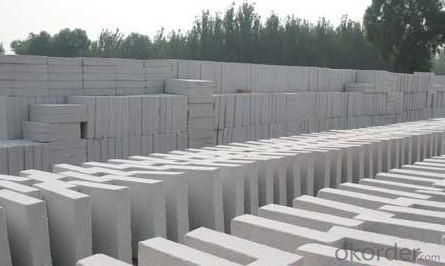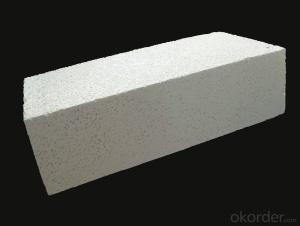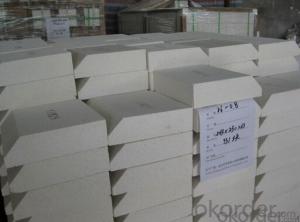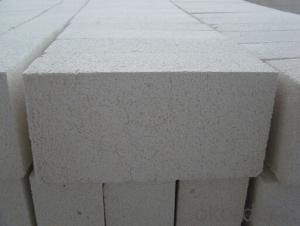Refractory Mullite Insulating Fire Brick JM 30
- Loading Port:
- Shanghai
- Payment Terms:
- TT OR LC
- Min Order Qty:
- 5000 kg
- Supply Capability:
- 100000 kg/month
OKorder Service Pledge
OKorder Financial Service
You Might Also Like
Top insulation ceramic fiber blanket
General information of ceramic fiber blanket
Cmax ceramic fiber blanket is made of high quality kaolin clay, centrifugal high purity alumina and silica or blowing process. It's no asbestos. Double side acupuncture for easy installation provides a lot of tension or strength of the blanket.
Products are divided into standard, high pressure, HA and Hz, respectively, corresponding to the highest service temperature of 1000, 1100, 1200, and 1350
Characteristics of ceramic fiber blanket
Heat resistance
Light weight
Low thermal conductivity
Low heat storage
Thermal shock toughness
High tensile strength
Application of ceramic fiber blanket
Refractory fiber lining for petrochemical process heating furnace
Heat treatment furnace or intermittent (shuttle) kiln heat surface lining
General oven standby insulation
Heat sealing or kiln kiln car door
Electrical insulation
Ceramic fiber blanket
Common problem solutions
1. What products do you have?
We have all kinds of refractory bricks, refractory casting materials, mortar, cement, ceramic fiber products, etc..
Or you can browse our products to choose what you need.
2. How to control product quality?
With strict quality control system throughout the material selection and production process, we have the quality of refractory materials and ceramic fiber products to meet customer requirements.
From the selection of raw materials, the quality of our control to start. The quality certificate of the raw material is required, each batch of the products are to be tested in the use of the forward line. In the production process, the quality control by the workers, and then each piece of classification, and through the quality supervision and inspection.
3. Can you give me a brief introduction to the application of your product?
My company is mainly engaged in refractories in the steel, cement, glass, ceramics, petrochemical, electric power and other industries.
4. What information do you need if I need you?
In order to select the right products, we will provide us with information, such as the United States, technical data, order quantity, product application, etc..
If you have any questions, please contact us.


FAQ
1. Which products do you have?
We have all kinds of refractory brick, castable, mortar, cement, ceramic fiber products, etc.
Or you could browse our products to choose what you need.
2. How do you control the products quality?
With strict quality control system throughout the materials selection and production process, our refractory and ceramic fiber products quality is effectively controlled to meet customer requirements.
From the raw materials selecting, our quality control begin. The quality certificates of raw materials are required and each batch will be tested before using. During production, the quality control are conducted by workers and then each piece will be sorted and examined by quality supervise.
3. Can you give me a brief introduction of the application of your products?
We are mainly specializing in the refractory materials in iron and steel, cement, glass, ceramics, petrochemical, electric power Industry, etc.
4. If I need your offer, what information do you need?
In order to choose suitable products, it will be appreciated to provide us the information, such us specification, technical data, order quantity, products application etc.
If any question, please contact us freely.
- Q:Are insulating fire bricks suitable for use in steel manufacturing plants?
- Yes, insulating fire bricks are suitable for use in steel manufacturing plants. Insulating fire bricks have excellent thermal properties, including high heat resistance and low thermal conductivity, which make them ideal for use in high-temperature environments such as steel manufacturing plants. These bricks can withstand the extreme heat generated during steel production processes, such as melting, casting, and forging. Additionally, insulating fire bricks help to conserve energy by reducing heat loss, thus improving the overall efficiency of the plant. They also have good mechanical strength and can withstand the physical stresses and strains associated with steel manufacturing operations. Overall, the use of insulating fire bricks in steel manufacturing plants can help to enhance safety, increase productivity, and improve energy efficiency.
- Q:How do insulating fire bricks affect the overall energy consumption of a kiln?
- The overall energy consumption of a kiln is greatly influenced by insulating fire bricks. These bricks are crucial in preventing heat transfer due to their low thermal conductivity. By incorporating these bricks into a kiln, the amount of heat lost to the surroundings is significantly reduced, resulting in improved energy efficiency. When the kiln is in operation, it is essential to properly insulate the walls to prevent the high temperatures inside from escaping. Failure to do so would require the kiln to continuously generate additional heat to maintain the desired temperature. However, insulating fire bricks act as a barrier, effectively trapping the heat within the kiln. This means that less energy is needed to achieve and sustain the desired temperatures, resulting in reduced energy consumption. Furthermore, insulating fire bricks also contribute to faster heat-up and cooling cycles. They have a low heat storage capacity, which means they do not absorb and retain heat for prolonged periods. Consequently, the kiln can quickly reach the desired temperature during the heating phase, reducing the time and energy required for optimal kiln operation. Similarly, during the cooling phase, insulating fire bricks aid in dissipating heat more rapidly, allowing for a quicker cooldown and lower overall energy consumption. In conclusion, insulating fire bricks have a significant impact on a kiln's overall energy consumption. By minimizing heat loss, improving energy efficiency, and facilitating faster heating and cooling cycles, these bricks contribute to substantial energy savings and decreased operating costs.
- Q:Can insulating fire bricks be used in industrial furnaces?
- Yes, insulating fire bricks can be used in industrial furnaces. Insulating fire bricks are specifically designed to withstand high temperatures and provide excellent insulation properties. They are made from lightweight refractory materials, such as alumina, silica, or mullite, which have low thermal conductivity. This allows them to efficiently trap heat within the furnace, reducing heat loss and improving energy efficiency. In industrial furnaces, where high temperatures are required for various processes like metal melting, glass manufacturing, or ceramic production, insulating fire bricks can be used to line the inner walls and floor of the furnace. Their insulation properties help to maintain a consistent temperature inside the furnace, ensuring optimal conditions for the industrial process. Insulating fire bricks also have the advantage of being lightweight, which makes them easier to handle and install compared to traditional dense fire bricks. This can save time and labor costs during the construction or repair of industrial furnaces. However, it is worth noting that the specific type and composition of insulating fire bricks should be carefully selected based on the operating temperature and requirements of the industrial furnace. Different types of insulating fire bricks have different temperature limits and resistance to thermal shock. Therefore, consulting with a professional or a refractory expert is recommended to ensure the right selection and installation of insulating fire bricks in industrial furnaces.
- Q:What are the main uses of insulating fire bricks?
- Insulating fire bricks, also known as IFBs, are primarily used in high-temperature applications where thermal insulation and heat resistance are required. These bricks are made from lightweight materials, such as clay, silica, and alumina, and are designed to withstand extreme temperatures. One of the main uses of insulating fire bricks is in the construction of kilns and furnaces. These bricks are used to line the walls, floors, and roofs of these high-temperature devices, providing insulation to prevent heat loss and improve energy efficiency. The insulating properties of IFBs help to maintain a consistent and controlled temperature inside the kilns and furnaces, allowing for more efficient heating and cooling processes. Insulating fire bricks are also commonly used in the construction of chimneys and flues. These bricks are resistant to the corrosive effects of flue gases and can withstand the high temperatures generated by the combustion process. The insulation provided by IFBs helps to prevent heat transfer to the surrounding structures, reducing the risk of fire and ensuring the safety of the chimney or flue. Additionally, insulating fire bricks find applications in the manufacturing of fireplaces, pizza ovens, and other outdoor cooking equipment. These bricks help to retain heat within the cooking chamber, allowing for even cooking and reducing fuel consumption. The insulating properties of IFBs also prevent the outer surfaces of these devices from becoming too hot, reducing the risk of accidental burns. Overall, the main uses of insulating fire bricks revolve around their ability to provide thermal insulation and heat resistance in high-temperature environments. Whether in kilns, furnaces, chimneys, or cooking equipment, these bricks play a crucial role in maintaining efficient heating processes, ensuring safety, and conserving energy.
- Q:Are insulating fire bricks suitable for use in kilns and furnaces?
- Insulating fire bricks are a suitable choice for kilns and furnaces, offering excellent thermal insulation that is ideal for applications requiring high temperatures. These bricks are specifically designed to provide outstanding thermal insulation, making them perfect for kilns and furnaces. With their low thermal conductivity, they effectively minimize heat loss, thereby enhancing energy efficiency. Furthermore, their lightweight and durable nature allows for easy installation and long-lasting performance in high-temperature environments. Not only are they resistant to thermal shock, but they also withstand rapid temperature changes, making them a reliable option for kilns and furnaces. Overall, insulating fire bricks are an exceptional choice for insulation and the maintenance of high temperatures in kilns and furnaces.
- Q:Is it possible to paint or coat insulating fire bricks?
- Yes, it is possible to paint or coat insulating fire bricks. However, it is important to use heat-resistant paints or coatings that can withstand high temperatures. Regular paints or coatings may not be suitable as they can crack or peel due to the intense heat. It is recommended to consult with a professional or refer to the manufacturer's guidelines to ensure the correct type of paint or coating is used for insulating fire bricks.
- Q:Can insulating fire bricks be used in high-temperature kilns for pottery?
- Yes, insulating fire bricks can be used in high-temperature kilns for pottery. Insulating fire bricks are specifically designed to withstand high temperatures, typically up to 3000°F (1650°C). These bricks have low thermal conductivity, which means they can effectively retain heat and provide insulation in kilns. Using insulating fire bricks in high-temperature kilns can help maintain a consistent temperature throughout the firing process, ensuring that the pottery is properly heated and cooled. Additionally, these bricks are lightweight, which makes them easier to handle and install in kilns. Overall, insulating fire bricks are a suitable choice for high-temperature kilns used in pottery.
- Q:Are insulating fire bricks resistant to high-pressure environments?
- Insulating fire bricks are not specifically designed to withstand high-pressure environments. While they are known for their excellent thermal insulation properties and resistance to high temperatures, their ability to withstand pressure is limited. Insulating fire bricks are typically used in low-pressure applications where their insulating properties are more important than their ability to withstand pressure. If a high-pressure environment is a concern, it is recommended to use other types of refractory bricks specifically designed for such conditions, like dense fire bricks or high-alumina bricks, which offer superior strength and resistance to pressure.
- Q:Can insulating fire bricks be custom-made?
- Indeed, it is possible to manufacture insulating fire bricks according to specific specifications. Typically, insulating fire bricks are crafted using lightweight materials like vermiculite, perlite, or refractory fibers, which are easily shaped into various forms and sizes. With this versatility, manufacturers can produce tailor-made insulating fire bricks to cater to specific demands and purposes. The customization options available may involve alterations in dimensions, thermal conductivity, compressive strength, and density. By adjusting the composition and design of the insulating fire bricks, they can be optimized to function optimally within specific temperature ranges, insulation requirements, and environmental conditions. Consequently, customers have the opportunity to collaborate with manufacturers in order to develop personalized solutions that perfectly align with their individual requirements.
- Q:Are insulating fire bricks suitable for use in aluminum smelting furnaces?
- Insulating fire bricks are not typically suitable for use in aluminum smelting furnaces. Aluminum smelting requires high temperatures, often exceeding 1,000 degrees Celsius, and insulating fire bricks are designed to have low thermal conductivity, meaning they are better at retaining heat rather than withstanding extreme temperatures. For aluminum smelting, refractory fire bricks or refractory castables are more appropriate. These materials have high melting points and are capable of withstanding the intense heat produced during the smelting process without losing their structural integrity. They also have good thermal shock resistance, which is important as the furnace may experience rapid temperature changes during operation. Additionally, refractory materials used in aluminum smelting furnaces should have good resistance to corrosion and chemical attack from the molten aluminum and other materials used in the process. Insulating fire bricks may not have the necessary chemical resistance, which could lead to premature degradation and failure of the furnace lining. In summary, while insulating fire bricks may be suitable for other applications that require good thermal insulation, they are generally not recommended for use in aluminum smelting furnaces. Refractory fire bricks or refractory castables are better suited for this high-temperature and chemically aggressive environment.
1. Manufacturer Overview |
|
|---|---|
| Location | |
| Year Established | |
| Annual Output Value | |
| Main Markets | |
| Company Certifications | |
2. Manufacturer Certificates |
|
|---|---|
| a) Certification Name | |
| Range | |
| Reference | |
| Validity Period | |
3. Manufacturer Capability |
|
|---|---|
| a)Trade Capacity | |
| Nearest Port | |
| Export Percentage | |
| No.of Employees in Trade Department | |
| Language Spoken: | |
| b)Factory Information | |
| Factory Size: | |
| No. of Production Lines | |
| Contract Manufacturing | |
| Product Price Range | |
Send your message to us
Refractory Mullite Insulating Fire Brick JM 30
- Loading Port:
- Shanghai
- Payment Terms:
- TT OR LC
- Min Order Qty:
- 5000 kg
- Supply Capability:
- 100000 kg/month
OKorder Service Pledge
OKorder Financial Service
Similar products
New products
Hot products
Related keywords




























